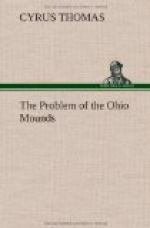CHAPTER II.
Similarity of the arts and customs of
the mound-builders to
those of Indians
Architecture
Tribal divisions
Similarity in burial customs
Removal of the flesh before burial
Burial beneath or in dwellings
Burial in a sitting or squatting posture
The use of fire in burial ceremonies
Similarity of the stone implements and
ornaments of various
tribes
Mound and Indian pottery
CHAPTER III.
Stone graves and what they teach
CHAPTER IV.
The Cherokees as mound-builders
CHAPTER V.
The Cherokees and the Tallegwi
INTRODUCTION.
No other ancient works of the United States have become so widely known or have excited so much interest as those of Ohio. This is due in part to their remarkable character but in a much greater degree to the “Ancient Monuments of the Mississippi Valley,” by Messrs. Squier and Davis, in which these monuments are described and figured.
The constantly recurring question, “Who constructed these works?” has brought before the public a number of widely different theories, though the one which has been most generally accepted is that they originated with a people long since extinct or driven from the country, who had attained a culture status much in advance of that reached by the aborigines inhabiting the country at the time of its discovery by Europeans.
The opinion advanced in this paper, in support of which evidence will be presented, is that the ancient works of the State are due to Indians of several different tribes, and that some at least of the typical works, were built by the ancestors of the modern Cherokees. The discussion will be limited chiefly to the latter proposition, as the limits of the paper will not permit a full presentation of all the data which might be brought forward in support of the theory, and the line of argument will be substantially as follows:
First. A brief statement of the reasons for believing that the Indians were the authors of all the ancient monuments of the Mississippi Valley and Gulf States; consequently the Ohio mounds must have been built by Indians.
Second. Evidence that the Cherokees were mound builders after reaching their historic seats in East Tennessee and western North Carolina. This and the preceding positions are strengthened by the introduction of evidence showing that the Shawnees were the authors of a certain type of stone graves, and of mounds and other works connected therewith.
Third. A tracing of the Cherokees, by the mound testimony and by tradition, back to Ohio.




